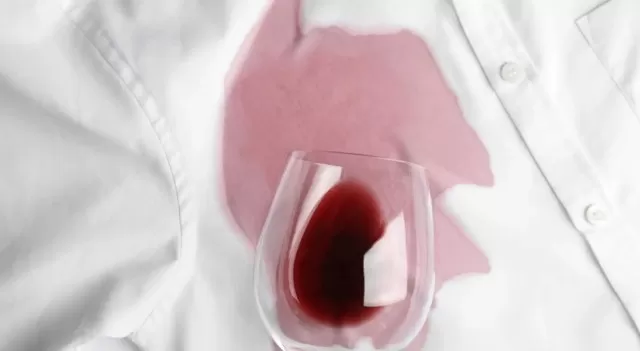In the comprehensive stain removal guide provided below, we offer effective strategies for getting rid of wine stains from various types of clothing.
Additionally, we’ll cover how to treat Red Wine Stains on common household materials such as carpet, stainless steel, ceramic tile, laminate flooring, and more.
Armed with these valuable tips, you can approach red wine stains with confidence, knowing you have the knowledge to remove them from any surface they may encounter.
Eliminating Red Wine Stains on Different Surfaces

Leather:
For leather surfaces, mix lukewarm water with mild Dish Soap to create suds in a jar.
Using only the suds, gently dab the stained area with a sponge. Wipe dry with a soft, clean cloth, and then apply a leather cleaner/conditioner following the manufacturer’s instructions.
Linen:
To treat wine stains on linen upholstery, begin by blotting the stain with warm, sudsy water, and then blotting it with a dry cloth.
Proceed by dabbing a 50-50 vinegar-water solution on the stain and blotting again. Repeat this process with warm, sudsy water and clear water until the stain is gone.
For washable linen garments, soak the stain in a mixture of lukewarm water, liquid dishwashing detergent, and white vinegar for 15 minutes.
Rinse and, if necessary, lightly sponge the stain with rubbing alcohol. If the stain persists, soak the garment in an enzyme solution, and if needed, launder it with a bleach product safe for the fabric.
Linoleum and Other Natural Resilient Floorings:
For these floorings, wipe the wine stain with rubbing alcohol, followed by a damp cloth.
If the stain remains, create a paste of baking soda and water to gently rub into the stain until it lifts. Rinse with clear water and dry.

Nylon:
When dealing with red wine stains on nylon, quickly rinse the affected area with cold water to dilute the stain.
Follow the guidelines on the garment care label and wash in the warmest water recommended. Inspect the stain, and if any wine remains, wash with color-safe bleach for colored items or liquid chlorine bleach for whites (if safe according to the label).
Air-dry and repeat as needed before drying as directed on the garment label.
Painted Walls:
To remove red wine stains from painted walls, dab with a sponge or soft cloth dipped in water, and then blot dry.
For persistent stains, apply a few drops of clear mild dish detergent and blot. Thoroughly blot with water and dry with a clean cloth.
In stubborn cases, use a multipurpose household cleaner following the manufacturer’s instructions, and then blot with clear water before drying.
Polyester:
To eliminate wine stains from polyester, promptly rinse the affected area with cold water to dilute the stain.
Wash according to the garment care label in the warmest water recommended. Inspect the stain, and if needed, use color-safe bleach for colored items or liquid chlorine bleach for whites (if safe according to the label).
Air-dry, inspect and repeat if necessary before drying as directed on the garment label.
By following these specific stain removal tips for various surfaces and materials, you can effectively handle red wine spills and maintain the cleanliness and appearance of your belongings and surfaces.
Remember to act swiftly, use the appropriate techniques, and always check the manufacturer’s instructions to ensure you treat the stains properly without causing damage.
Dealing with Red Wine Stains on Silk:

To effectively address red wine stains on delicate silk fabric, follow these steps:
Blot to Remove Excess Wine: Act swiftly and gently blot the stain with a clean cloth or paper towel to remove as much wine as possible.
Avoid rubbing, as it could spread the stain and damage the delicate silk fibers.
Blot with Cool Water: Continue blotting the stain with cool water until you notice that the wine is no longer transferring to the cloth.
This helps dilute the stain and prevent it from setting further into the silk.
Dab with Mild Dish Soap and White Vinegar: If the stain persists, create a solution by combining mild clear dish soap with a few drops of white vinegar.
Lightly dab this mixture on the stain, but be sure to test it on an inconspicuous spot of the silk first to ensure it doesn’t cause any adverse effects. Blot with water afterward, and then blot the area dry.
Repeat this process until the stain begins to lift.
Consider Hydrogen Peroxide: If the wine stain remains stubborn, as a last resort, you can try blotting the area with hydrogen peroxide.
However, it’s crucial to test this on a hidden part of the silk first to avoid any potential damage. After using hydrogen peroxide, blot with clear water, and then dry the area with gentle blotting.
Silk is an exquisite and delicate fabric, so it’s essential to approach stain removal with caution and care.
Act quickly to prevent the stain from setting in, and use gentle techniques to gradually lift the wine stain without harming the silk’s integrity.
If the stain is particularly persistent or valuable, it may be wise to seek professional cleaning services specializing in treating delicate fabrics like silk.
They will have the expertise and tools to remove the stain effectively while safeguarding the silk’s luxurious texture and appearance.
Remember, the key to successful stain removal on silk is to act promptly, use appropriate Cleaning Solutions in small amounts, and perform tests on inconspicuous areas to ensure compatibility.
With patience and gentle care, you can restore your silk items to their original beauty, free from pesky red wine stains.
*The information is for reference only.